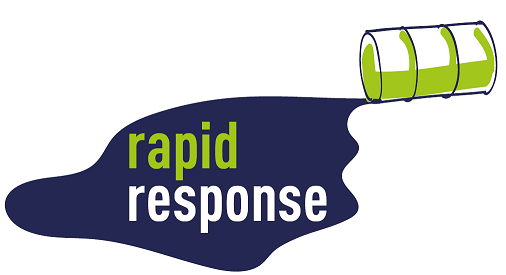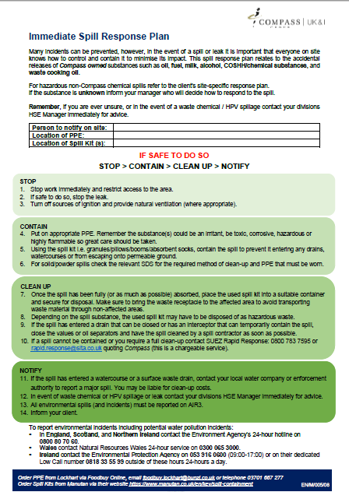Spill Response
We carry out many activities that could present a pollution risk, such as a spillage, emissions to air, litter and fly-tipping, nuisances and activities that may harm local biodiversity.
If our pollution risks are not managed effectively, they could result in:
- Release of greenhouse gas (GHG) emissions which contribute to climate change;
- Damage the land, contaminate water, and destroy habitats within;
- Fines and prosecutions for causing a pollution incident or committing a waste crime, which are significant.
Spill kits can be ordered from: Compass Sites - Manutan & CH&CO - Safe & Sound

Emergency Response
Rapid Response is a fast and reliable emergency waste and clean-up service. To discuss your emergency, call 0800 783 7595 or email rapid.response@sita.co.uk, quoting "Compass".
Download the flyer to find out more.
Prices are based on actual weight, not volume. Proof of collection is recovered and waste transfer notes are sent via email.
Immediate Spill Response Plan
Train your teams on how to respond to a spill and display on site:
Environmental Damage
If you or your activities threaten to cause, or have caused, environmental damage you must:
• Take steps to prevent the damage (or further damage) occurring
• Inform the local authority who will tell you what you must do to repair the damage.
An operator that causes environmental damage is legally and financially liable for the damage caused and subsequent remediation work.
How can we reduce pollution risks?
We carry out many activities that could have pollution risks on site, such as:
Local nuisances (such as noise, odour, light, dust, vibration, visual)
Litter and fly-tipping (illegal dumping of waste)
Use of refrigeration and air conditioning equipment
Storage of hazardous substances (e.g. oil, gas, liquid, paints, solvents and chemicals)
Use of boilers and furnaces
Activities that may harm local biodiversity
Risk of fire, explosion or flooding
Historical building or land contamination issues (e.g. asbestos, contaminated land, radon area)
Transport of dangerous goods
If our pollution risks are not managed effectively, they could result in:
- Release of greenhouse gas (GHG) emissions which contribute to climate change
- Damage to watercourses and aquatic life within them
- Damage to land and habitats
If you or your activities threaten to cause, or have caused, environmental damage you must:
- Take steps to prevent the damage (or further damage) occurring
- Inform the local authority who will tell you what you must do to repair the damage.
An operator that causes environmental damage is legally and financially liable for the damage caused and subsequent remediation work.All activities should be carried out in such a way to avoid pollution incidents. Here's how you can manage your pollution risks:
Local Nuisances
If you carry out activities that could give rise to complaints in the local area (such as noise, odour, light, dust, vibration, visual) make sure that you confine activities (including building work) to the daytime wherever possible. Make sure that you know who to contact to report a nuisance or anti-social behaviour (e.g. your local police).
Litter and Fly-Tipping (illegal dumping of waste)
Litter is waste that has been discarded without consent in an inappropriate location (e.g. on to the ground). Cigarette butts and food and drink packaging are the most common types of litter in the UK. Visual pollution is the major effect of litter and it is a threat to public health. Thousands of animals are injured every year due to litter, for example from sharp edges on cans, broken glass, and plastic bags and can holders. Go to the RSPCA website to find out more. Removing litter is costly. Please make sure your waste is disposed of responsibly.
Fly-tipping is the illegal deposit of any waste on to land, or any waste dumped or tipped on a site with no licence to accept waste. It is a criminal offence. Fines are normally defined by the council that operates in the local area. Common types of fly-tipped waste are cars, white goods, and construction waste, some of which may be hazardous or toxic. All businesses must have a contract with a registered waste carrier and your waste must be taken to a site that is licensed to take commercial waste.
Refrigeration Equipment (F-Gases and Ozone Depleting Substances)
Fluorinated gases (F-gases) are a group of chemicals containing fluorine. F-gases are powerful greenhouse gases that trap heat in the atmosphere and contribute to global warming.
Ozone-depleting substances (ODS) are gases which damage the ozone layer in the upper atmosphere. They are being phased out, but can be found in older equipment but there are a few exceptions.
Common uses for ODS and F-gases include refrigeration and air-conditioning equipment, aerosols, solvents, foam blowing agents, firefighting fluids and high voltage switchgear.
Who it affects:
If you manufacture, supply, use, install or service equipment containing F-gases or ODS, you must comply with legislation as described below. Check with your client whether this is Compass Group's or their responsibility.
What you have to do:
Check the name plate mounted on the equipment or refer to the documentation provided with it to answer the following questions, or download and print the Refrigerant Guide.
1) Does your air conditioning and refrigeration equipment use CFC refrigerants: R11, R12, R13, R113, R114, R115, R500, R502, R503?
If yes, the use of CFCs were banned in from 1st January 2001 - Equipment should have been replaced or a CFC replacement sought.
2) Does your air conditioning and refrigeration equipment use R22, R408A or other HCFC refrigerants?
If yes:
(i) Carry out annual leak testing, and
(ii) Plan for phase out as the use of virgin HCFCs such as R22 has been banned since the end of 2009, and the use of recycled/reclaimed HCFCs were banned from 1st January 2015. Equipment should be replaced or a HCFC replacement sought. Find out more about the R22 phase out.
3) Does your air conditioning and refrigeration equipment use HFC refrigerants: R403A&B, R134a, R404A, R407C, R410A?
If yes, for systems with more than 3kg of HFC refrigerants:
(i) Keep an inventory of air conditioning and refrigeration equipment
(ii) Keep records of equipment maintenance
(iii) Make sure that only qualified personnel deal with refrigerants
(iv) Make sure that the organisation dealing with refrigerants holds a company certificate
(v) Carry out leak testing at least annually (systems containing >30kg require more regular testing)
(vi) Systems containing 300kg or more must have automatic leak detectors fitted
For systems with less than 3kg of HFC refrigerants:
(i) Prevent leakage of HFC refrigerants and
(ii) Repair leaks as soon as they are detected.
Find out more about managing fluorinated gases and ozone-depleting substances.
Storage of Hazardous Substances
This section covers storage of waste oil, fuel oil, gas, liquid, paints, solvents and chemicals.
Pollution Risk Assessment
Completing a Pollution Risk Assessment can help you understand your pollution risks and identify the measures you need to take to reduce the likelihood and impact.
Chemicals, oil, or fuel delivered via pipeline or tanker
If you receive or store bulk liquid or gas via pipeline or tanker, please use the following procedures:
- ENV16 - Bulk Liquid Delivery Procedure
- ENV17 - Bulk Gas Delivery Procedure
- ENV18 - Fuel Delivery Form
- ENV19 - Pipework, Tank and Bund Procedure
- ENV20 - Bulk Tank Inspection Form
Offshore only: Storage of carbon dioxide
If you store carbon dioxide, you must hold a licence and ensure storage areas routinely checked.
For further information, please visit: Oil and gas: licensing for carbon storage
Flood Risk Assessment and Planning
If your site is in close proximity to a waterway, dam, reservoir, river or stream it could be at risk of flooding. Check on the Environment Agency website to see if your site is at risk. The Environment Agency publish flood warnings online 24 hours a day.
If your site is in flood risk area, work with your client to ensure that you have a written plan for how you will respond to a flood. The plan should include:
- How you will protect staff
- How you will deal with hazardous equipment
- How you will reduce the risk from polluting materials
Download the guidance on preparing your business for flooding.

